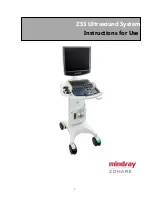
Acessa
®
ProVu System User’s Guide
PL-01-0040
CO 20-131 Revision: C
28
14.
Postmarket Surveillance Study – TRUST (Treatment Results of Uterine Sparing Technologies)
14.1.
Summary of the Post-Approval Study Methods
14.1.1.
Study Objective
The study objectives were to compare the rates of acute and near-term serious complications in the Acessa
subjects to the acute and near-term treatment-related serious adverse event rates of the pivotal (pre-market)
study.
14.1.2.
Study Design
A multi-center, prospective, randomized, controlled, clinical trial, conducted at 11 sites in the U.S. and 3 sites
in Canada.
14.1.3.
Study Population
Premenopausal female patients
≥
18 years old who had symptomatic fibroids, who desired uterine
conservations, and who were indicated for a surgical intervention for their symptoms were enrolled in the
study.
14.1.4.
Data Source
Data were collected prospectively on each subject using dedicated case report forms that were source verified
at all study visits.
14.2.
Key Study Endpoints
14.2.1.
Primary Endpoint
The primary endpoint was the overall rates of acute (within 48 hours post procedure) and near-term (between
2 and 30 days post procedure) serious complications in all GFA (Acessa) subjects compared to the acute and
near-term treatment-related serious adverse event rates in the pivotal study.
14.2.2.
Secondary Endpoint
The secondary endpoint was the incidence of serious complications per investigator-surgeon during training
and post training.
14.3.
Total Number of Enrolled Study Sites
14 sites in the United States and Canada enrolled participants in the study.
14.4.
Total Number of Enrolled Subjects and Follow-up Rate
A total of 110 participants were enrolled. Five (5) subjects withdrew or were withdrawn prior to treatment. 105 subjects
were treated per protocol between April 25, 2014 and October 2, 2017.
Table 14.1
shows that of the 105 treated subjects, 100 completed both the 48-hour and 30-day follow up visits.
Table 14.1
Number and percentage of subjects reaching each designated study phase
Number
of
Subjects
Treated
Number
and
Percentage of
Subjects With
48-hour Data
(Median=2
days)
Number
and Percentage
of Subjects With
1 Week Data
(Median=7 Days)
Number and
Percentage of
Subjects With 30-day
Data
(Median=37.5 days)
Number
and Percentage of
Subjects Who Have
Completed the 522
Requirements
(48 hr and 30 Days)
Number
and percentage of
subjects lost to
follow up before 30
days
105/105
(100%)
101/105
1
(96.2%)
100/105
(95.2%)
104/105
2
(99.0%)
100/105
(95.2%)
1/105
2
(0.95%)
1
Two subjects missed the 48-hour visit but reported no serious complications at the 1-week visit and two additional subjects
missed
both the 48-hour visit and the 1-week visit but were followed by investigator on at the 30-day visit.
2
One (1) subject was lost to follow up after the 48-hour visit but reported no serious complications at that time. Note that
percentage is based on total number of subjects treated.
14.5.
Study visits and length of follow up
After passing screening, subjects’ baseline and procedure data were recorded. Subjects were followed at 48 hours
(window 24-72 hours), 1 week (window 5-12 days), and 1 month (window 4-8 weeks) post treatment to assess for acute
and near-term serious complications.














































